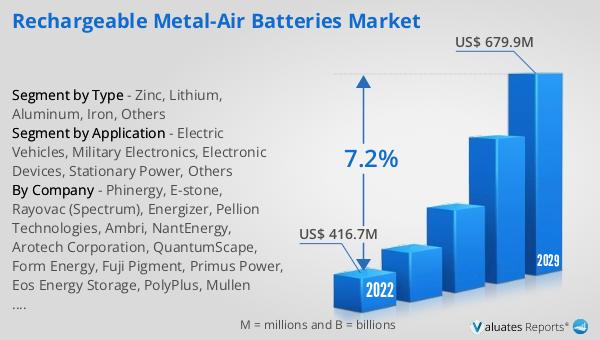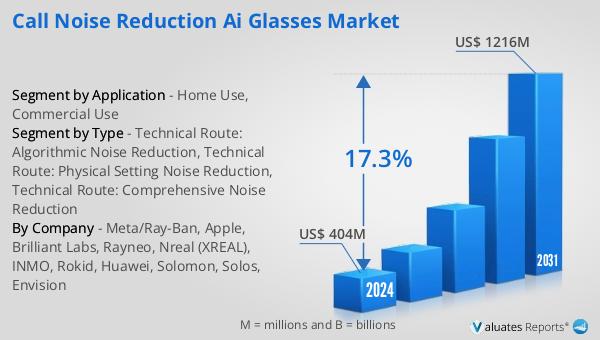What is Global Rechargeable Metal-Air Batteries Market?
The Global Rechargeable Metal-Air Batteries Market is an emerging sector in the energy storage industry, characterized by its innovative approach to harnessing the power of metal-air chemistry. These batteries utilize metals such as zinc, lithium, aluminum, and iron as anodes, while oxygen from the air acts as the cathode. This unique configuration allows for a high energy density, making them a promising alternative to traditional lithium-ion batteries. The market is driven by the increasing demand for efficient, lightweight, and cost-effective energy storage solutions across various applications. Rechargeable metal-air batteries are particularly appealing due to their potential for long cycle life and environmental friendliness, as they often use abundant and non-toxic materials. The market is witnessing significant research and development efforts aimed at overcoming challenges such as limited rechargeability and air cathode stability. As industries seek sustainable and high-performance energy solutions, the global rechargeable metal-air batteries market is poised for growth, offering a promising avenue for advancements in electric vehicles, portable electronics, and renewable energy storage systems. The ongoing innovations and collaborations among key players are expected to further enhance the capabilities and commercial viability of these batteries, paving the way for their widespread adoption in the coming years.

Zinc, Lithium, Aluminum, Iron, Others in the Global Rechargeable Metal-Air Batteries Market:
In the realm of rechargeable metal-air batteries, various metals serve as the core component, each offering distinct advantages and challenges. Zinc-air batteries are among the most developed and widely used in this category. They are known for their high energy density and cost-effectiveness, making them suitable for applications like hearing aids and other small electronic devices. Zinc is abundant and relatively inexpensive, which contributes to the economic feasibility of these batteries. However, the challenge lies in improving their rechargeability and cycle life, as traditional zinc-air batteries are primarily designed for single-use. Efforts are underway to enhance the reversibility of the zinc-air battery system, which could significantly expand its application range. Lithium-air batteries, on the other hand, are considered the holy grail of battery technology due to their theoretical energy density, which is comparable to that of gasoline. This makes them highly attractive for electric vehicles and large-scale energy storage. The primary challenge with lithium-air batteries is their complex chemistry, which leads to issues such as poor cycle life, low efficiency, and the formation of unwanted by-products during discharge and recharge. Researchers are actively exploring various approaches to stabilize the lithium-air system, including the development of new electrolytes and catalysts that can enhance performance and longevity. Aluminum-air batteries are another promising type of metal-air battery, known for their high energy density and lightweight nature. Aluminum is the most abundant metal in the Earth's crust, making it an attractive option from a resource availability standpoint. These batteries have been explored for use in electric vehicles and military applications due to their potential for long-range and high energy output. However, like other metal-air batteries, aluminum-air systems face challenges related to rechargeability and the management of by-products formed during operation. Innovations in electrode design and electrolyte composition are being pursued to address these issues and improve the practicality of aluminum-air batteries. Iron-air batteries, while less developed than their zinc, lithium, and aluminum counterparts, offer a unique set of advantages. Iron is abundant, inexpensive, and environmentally benign, making it an appealing choice for sustainable energy storage solutions. Iron-air batteries have the potential for long cycle life and are being considered for grid-scale energy storage applications. The main challenge with iron-air systems is their relatively low energy density compared to other metal-air batteries. Research is focused on enhancing the efficiency and energy output of iron-air batteries through advancements in electrode materials and cell design. Beyond these specific metals, the category of "others" in the metal-air battery market includes emerging technologies and experimental systems that utilize different metals or hybrid configurations. These systems are in various stages of research and development, with the aim of overcoming the limitations of existing metal-air batteries and exploring new possibilities for energy storage. The diversity of metals and configurations being explored highlights the dynamic nature of the rechargeable metal-air batteries market, as researchers and companies strive to unlock the full potential of this innovative technology. As advancements continue, the integration of these batteries into mainstream applications is expected to accelerate, driven by the need for efficient, sustainable, and high-performance energy storage solutions.
Electric Vehicles, Military Electronics, Electronic Devices, Stationary Power, Others in the Global Rechargeable Metal-Air Batteries Market:
The Global Rechargeable Metal-Air Batteries Market finds its applications across a wide range of sectors, each benefiting from the unique advantages offered by this technology. In the realm of electric vehicles (EVs), metal-air batteries are particularly appealing due to their high energy density and lightweight nature. These characteristics are crucial for extending the driving range of EVs while maintaining efficiency. Metal-air batteries, especially lithium-air and aluminum-air types, are being explored as potential alternatives to traditional lithium-ion batteries, offering the promise of longer range and reduced weight. However, challenges related to rechargeability and cycle life need to be addressed before they can be widely adopted in the automotive industry. In military electronics, the demand for reliable and portable power sources is paramount. Metal-air batteries offer a compelling solution due to their high energy density and potential for long-lasting power supply. These batteries can be used in various military applications, including communication devices, sensors, and unmanned vehicles, where weight and energy efficiency are critical factors. The ability to operate in diverse environmental conditions further enhances their suitability for military use. Ongoing research is focused on improving the durability and rechargeability of metal-air batteries to meet the stringent requirements of military applications. Electronic devices, ranging from smartphones to laptops, are another area where metal-air batteries hold significant promise. The ever-increasing demand for longer battery life and faster charging times has driven interest in alternative battery technologies. Metal-air batteries, with their high energy density, could potentially offer extended usage times for portable electronic devices. However, the current limitations in rechargeability and cycle life need to be overcome to make them a viable option for consumer electronics. Innovations in battery design and materials are being pursued to address these challenges and unlock the full potential of metal-air batteries in this sector. Stationary power applications, such as grid energy storage and backup power systems, represent another significant opportunity for metal-air batteries. The ability to store large amounts of energy efficiently and cost-effectively is crucial for integrating renewable energy sources like solar and wind into the power grid. Metal-air batteries, particularly iron-air and zinc-air types, are being explored for their potential to provide long-duration energy storage solutions. These batteries can help stabilize the grid by storing excess energy during periods of low demand and releasing it during peak times. Research efforts are focused on enhancing the scalability and efficiency of metal-air batteries for stationary power applications. Beyond these specific areas, the "others" category encompasses a wide range of potential applications for metal-air batteries. This includes emerging technologies and niche markets where the unique properties of metal-air batteries can be leveraged. For instance, they could be used in remote sensing devices, medical implants, and other specialized applications where lightweight and high-energy storage solutions are required. The versatility of metal-air batteries, combined with ongoing advancements in materials and design, opens up new possibilities for their integration into various industries. As the technology matures, the adoption of metal-air batteries in diverse applications is expected to increase, driven by the need for efficient, sustainable, and high-performance energy storage solutions.
Global Rechargeable Metal-Air Batteries Market Outlook:
The outlook for the Global Rechargeable Metal-Air Batteries Market is promising, with significant growth anticipated over the coming years. In 2024, the market was valued at approximately US$ 477 million, reflecting the growing interest and investment in this innovative energy storage technology. By 2031, the market is projected to expand to a revised size of US$ 771 million, driven by a compound annual growth rate (CAGR) of 7.2% during the forecast period. This growth trajectory underscores the increasing demand for efficient, lightweight, and cost-effective energy storage solutions across various sectors. The unique advantages of metal-air batteries, such as high energy density and environmental friendliness, are key factors contributing to their rising popularity. As industries continue to seek sustainable and high-performance energy solutions, the market for rechargeable metal-air batteries is expected to witness significant advancements and adoption. The ongoing research and development efforts aimed at overcoming challenges related to rechargeability and cycle life are likely to enhance the commercial viability of these batteries. With continued innovation and collaboration among key players, the global rechargeable metal-air batteries market is poised for substantial growth, offering a promising avenue for advancements in electric vehicles, portable electronics, and renewable energy storage systems.
| Report Metric | Details |
| Report Name | Rechargeable Metal-Air Batteries Market |
| Accounted market size in year | US$ 477 million |
| Forecasted market size in 2031 | US$ 771 million |
| CAGR | 7.2% |
| Base Year | year |
| Forecasted years | 2025 - 2031 |
| by Type |
|
| by Application |
|
| Production by Region |
|
| Consumption by Region |
|
| By Company | Phinergy, E-stone, Rayovac (Spectrum), Energizer, Pellion Technologies, Ambri, NantEnergy, Arotech Corporation, QuantumScape, Form Energy, Fuji Pigment, Primus Power, Eos Energy Storage, PolyPlus, Mullen Technologies, Duracell, Panasonic, EnZinc, Renata SA, ZAF Energy System, Alcoa, GP Industrial |
| Forecast units | USD million in value |
| Report coverage | Revenue and volume forecast, company share, competitive landscape, growth factors and trends |
